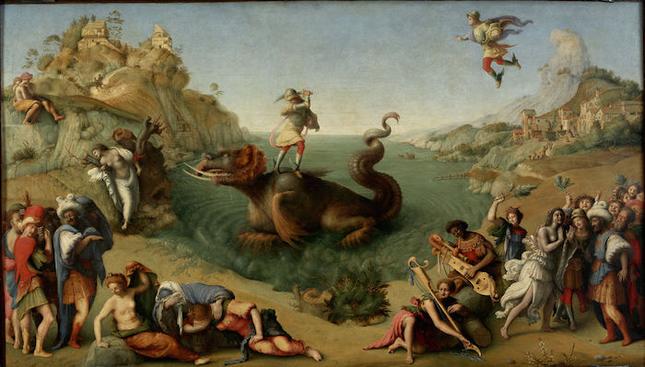Whimsy and Worship: the Eccentric Piero di Cosimo at the National Gallery
By • February 23, 2015 0 1979

Piero di Cosimo’s paintings never reached the canon of High Renaissance art inhabited by Leonardo, Michelangelo, Raphael and even Giorgione works. Yet his pieces, a myriad of which are on exhibit now at the National Gallery, show a fun-loving, eccentric artist bounding from style to style all while demonstrating the aristocratic tastes of that period in which both whimsical mythology and devout adoration were sought after for personal consumption.
Piero’s birth, in 1462, proceeded Michelangelo’s and preceded Leonardo’s by about a decade each, respectively. Like other artists of the era, the Florentine Piero was given biographical treatment by the one and only Giorgio Vasari in his “Lives of the Artists” writings, which chronicled with debatable veracity of exactly that. Vasari, Piero’s only biographer, painted a picture of bizarre, even outlandish man in his writings.
He wrote that Piero suffered from such bad pyrophobia that he subsisted solely on eggs that he boiled (fifty at a time) with the glue he worked with. According to Vasari, Piero lived “more like a beast than a man” with regard to cleanliness, preferred animals to humans and had a propensity for seeing beauty in the lowliest street scene.
Vasari’s passages on Piero ring truest and with most relevance for today when he writes that Piero “changed his style almost from one work to the next.” That much is apparent in the National Gallery’s six-gallery-spanning retrospective “Piero di Cosimo: The Poetry of Painting in Renaissance Florence.”
Upon entering the exhibit, visitors are greeted by Piero’s “Madonna and Child Enthroned with Sts. Peter, John the Baptist, Dominic, and Nicholas of Bari,” a painting clearly influenced by colleague Fillipino Lippi (and the International Gothic Style) but with the High Renaissance in mind. Piero uses Lippi’s bright palette and fanciful adornments in dressing the figures, whose sharp contours flatten the painting. There is balance though, which carries through in three paintings in the predella where scenes involving St. John the Baptist, St. Dominic and St. Nicholas of Bari are neatly arranged with figures, slopes and vegetation that create a sense of balance.
“The Finding of Vulcan on Lemnos” continues the Lippi-esque style in the next gallery, but with pagan subjects, flirtatiousness, nudity and highly detailed deptictions of flowers, birds and plants. In “Vulcan and Aeolus,” Piero shows a naturalist tendency again, including, most notably, a giraffe but also a number of birds and smaller mammals in a pagan scene. (The giraffe was given to Florence’s leader Lorenzo de’ Medici as a gift from the Sultan of Egypt but met an untimely death after hitting its head on a low palace entrance.)
Nature runs wild in a subsequent piece, “The Hunt,” depicting lions, tigers and bears (oh my!), not to mention satyrs, deer, beavers and the men who have ignited a fire in the woods in order to slay all of these animals. The organized chaos of Piero’s “Hunt” comes to a serene end in “The Return from the Hunt,” where women take stock of animal carcasses and even nurse a bear cub that’s been separated from its mother. Oddly enough, the set was a wedding gift for
In the epic “Perseus Freeing Andromeda” Piero is near-Boschian in constructing the peculiar sea monster sent by Poseidon to capture Andromeda, the daughter of Ethiopian king Cepheus. Piero doesn’t quite nail human skin tone in th work, as Andromeda and other figures meant to be black appear sickly more than anything else. But Flemish inspiration leads to incredibly detailed illustrations of water, landscape and architecture in the background. (Details in the background of “The Visitation of Saint Nicholas and Saint Anthony Abbot,” too.)
Piero’s devotional tondi come as a surprise then when juxtaposed with his fanciful, mythological works. Traditionally, a tondo is a circular piece of art given to a bride upon marriage. Piero’s works in the medium vary in style with Piero giving some a Flemish attention to detail and others the forms of a Leonardo painting. Nonetheless, all of the works are rife with devotion and matronly emotion showing, perhaps, a more devout artist than his mythology suggests. “Mary Adoring the Child” and “Madonna and Child with Saints and Angels” stand out the most in this regard.
The National Gallery’s retrospective makes clear that Piero di Cosimo, despite and maybe even because of his eccentricities, was a masterful painter. Had he stuck with and built one style or streamlined his subjects more effectively, maybe he would be considered a master today. But then the National Gallery’s exhibit wouldn’t be so much fun.

